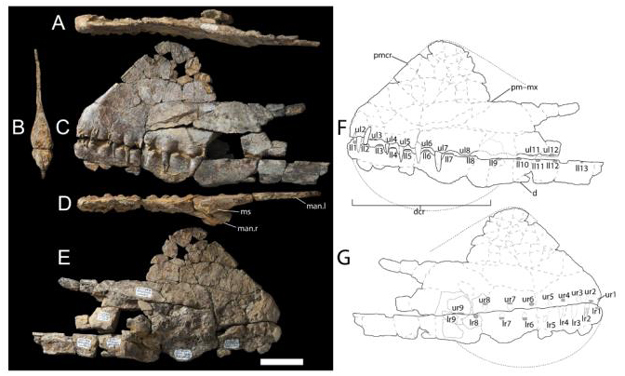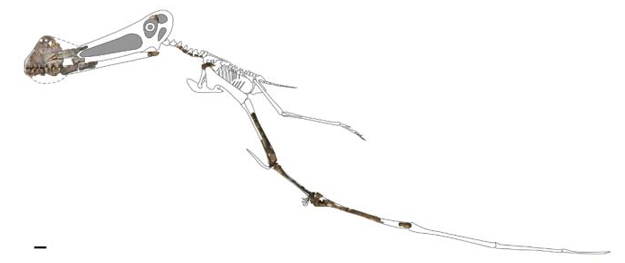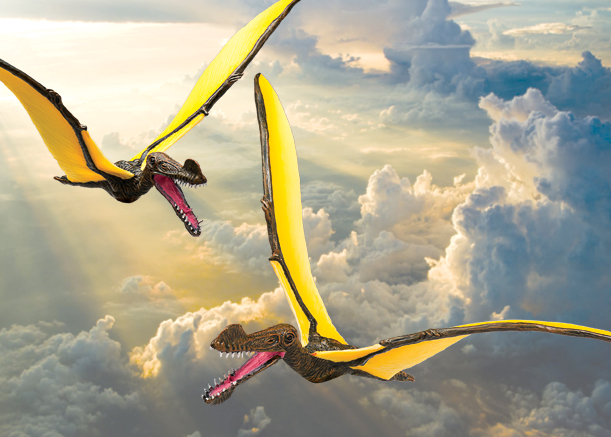Most Complete Pterosaur Specimen Found in Australia to Date
Ferrodraco lentoni – The “Iron Dragon”
The fossil record for pterosaurs “down under” is extremely poor. Only around twenty very fragmentary specimens are known. However, a team of scientists, including researchers from the Australian Age of Dinosaurs Museum (Winton, Queensland), have announced the discovery of a new species of flying reptile, what is more, the new species named Ferrodraco lentoni represents the most complete pterosaur known from Australia.
The Holotype Skull and Mandible of Ferrodraco lentoni

Picture credit: Scientific Reports
A Close Neighbour of Savannasaurus elliottorum
Local farmer Bob Elliott discovered the specimen eroding out of a bank adjacent to a small creek on Belmont Station in early 2017, the fossilised remains, although fragmentary, represent a type of flying reptile known as an ornithocheirid, a family of pterosaurs with a global distribution, with specimens known from the Americas, Europe, North Africa, Asia and with two Queensland representatives already – Aussiedraco and Mythunga. Bob Elliott took some of the fossils to the experts at the Australian Age of Dinosaurs Museum and a field team was despatched to excavate the rest of the material.
The pterosaur fossil material includes parts of the skull, the tips of the jaws, five partial vertebrae, limb bones and around forty isolated and broken teeth. The pterosaur fossils were found less than five miles from the site of the Savannasaurus elliottorum quarry. Savannasaurus was a huge sauropod dinosaur, it was discovered in 2005 and formally described in 2016. To read about Savannasaurus: Titanosaurs Crossing Continents Savannasaurus elliottorum.
A Skeletal Reconstruction of Ferrodraco lentoni (based on Tropeognathus mesembrinus)
Picture credit: Scientific Reports – based on an illustration by Mark Witton
Ferrodraco lentoni – Named after the Late Mayor of Winton
The genus name is a reference to the ironstone preservation of the holotype specimen, and the Latin “draco” (dragon). The species name honours former Winton Shire mayor Graham Thomas “Butch” Lenton, in recognition of his years of service to the Winton community and his strong support for the Australian Age of Dinosaurs Natural History Museum.
Ferrodraco is estimated to have lived some 96 million years ago and it is thought to have had a wingspan of around four metres. Corresponding author for the scientific paper, published in the journal Scientific Reports, Adele Pentland, a PhD student at the Australian Age of Dinosaurs Museum, commented:
“Ferrodraco would have been an apex aerial predator around 96 million years ago. At this time the Winton region was on the southern shores of an inland sea and was globally positioned about where Victoria’s southern coastline is today.”
A Life Reconstruction of Ferrodraco lentoni (Based on Tropeognathus mesembrinus)
The picture (above) shows a pterosaur model from the Mojo Fun range.
To view this range of prehistoric animal figures: Mojo Fun Prehistoric and Extinct Figures.
The scientific paper: “Ferrodraco lentoni gen. et sp. nov., a new ornithocheirid pterosaur from the Winton Formation (Cenomanian–lower Turonian) of Queensland, Australia” by Adele H. Pentland, Stephen F. Poropat, Travis R. Tischler, Trish Sloan, Robert A. Elliott, Harry A. Elliott, Judy A. Elliott and David A. Elliott published in Scientific Reports.
The Everything Dinosaur website: Everything Dinosaur.



